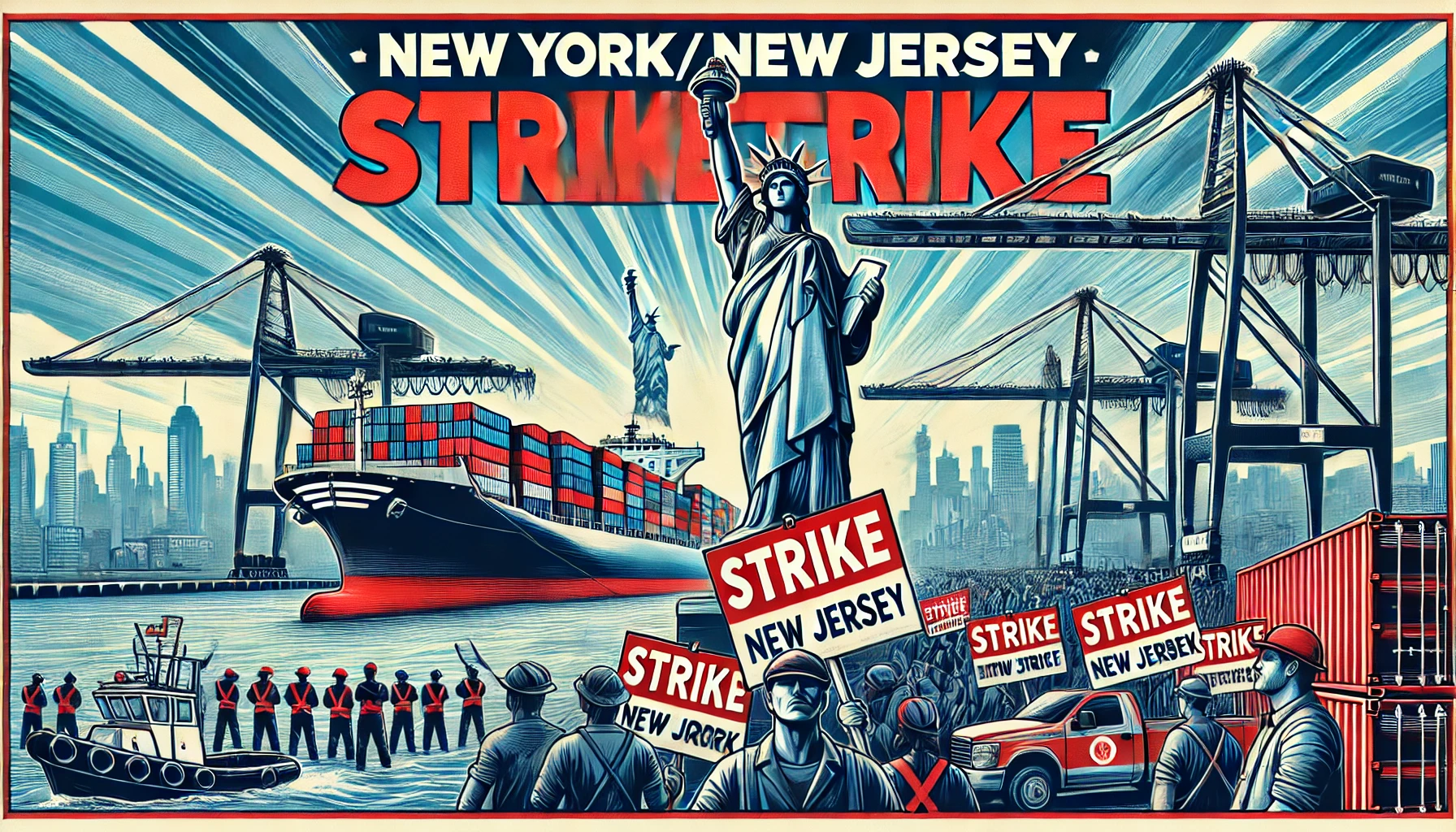Navigating the First New York/New Jersey Port Strike Since 1977: Labor, Automation, and Economic Consequences
The New York/New Jersey port strike, poised to be the first of its kind since 1977, has the potential to disrupt not only regional shipping operations but also national supply chains and the U.S. economy at large. The looming strike involves thousands of longshoremen from the International Longshoremen’s Association (ILA) and threatens to bring major ports on the U.S. East Coast to a standstill. With automation, labor rights, and economic pressures at the core of the negotiations, the potential for this strike to reshape port operations in the U.S. is significant.
In this blog, we explore the reasons behind the strike, the key players, and the potential impact of port strikes on the U.S. economy. We’ll also look at the broader issues of labor negotiations, automation, and what to expect if the strike proceeds.
The Historical Significance of the New York/New Jersey Port Strike
If the strike occurs, it will be the first East Coast port strike since 1977, a critical point in U.S. labor history. The New York New Jersey port strike is particularly notable due to the size and importance of these ports. They collectively handle approximately 20% of U.S. shipping imports and are crucial to maintaining the flow of goods, especially as supply chains are still recovering from the disruptions caused by the pandemic.
In 2024, tensions between the ILA and the United States Maritime Alliance (USMX) have reached a boiling point. At the heart of the matter are issues related to wages, working conditions, and the increasing threat of automation—a topic that has created rifts between management and labor. This potential strike is not just a regional issue but one that has the potential to send ripples across the entire economy.
Longshoremen Strike 2024: What’s Driving the Labor Dispute?
The longshoremen strike in 2024 has been years in the making. Contract negotiations between the ILA and the USMX have broken down repeatedly, with wage increases and working conditions taking center stage. Longshoremen are crucial to port operations, responsible for unloading ships and managing the flow of cargo that enters and exits the U.S. via these key coastal hubs.
As of September 2024, over 45,000 dockworkers are prepared to strike if a deal is not reached by the October 1 deadline. Union president Harold Daggett has emphasized that the workers’ demands are long overdue, including a 77% pay raise over a six-year period to address inflation and the rising cost of living. The New Jersey dockworker strike also highlights another key issue—automation in U.S. ports.
Automation: The Core of the Dispute
One of the most contentious points in the negotiations revolves around the increasing use of automation in U.S. ports. Many ILA members fear that automated technologies will eventually replace their jobs. Automation allows ports to operate more efficiently, but it comes at a significant cost to human labor. U.S. ports, unlike many of their counterparts in Asia and Europe, have been slower to adopt full automation, but the pressure to modernize is growing.
Proponents of automation argue that it would reduce operational costs and increase the competitiveness of U.S. ports. However, longshoremen argue that while automation may reduce the need for manual labor, it comes at the cost of job security and could eliminate thousands of well-paying jobs in the long run. With New Jersey dockworker strike talks stalling over this issue, the future of automation remains a pivotal point in the labor dispute.
The Potential Impact of Port Strikes on the U.S. Economy
The impact of port strikes on the U.S. economy cannot be overstated. As one of the largest ports on the East Coast, the Port of New York plays a critical role in U.S. supply chains. A prolonged East Coast port strike would disrupt the flow of goods, including essential items such as pharmaceuticals, electronics, and automotive parts. According to logistics experts, even a brief strike could cause significant disruptions in shipping schedules, leading to U.S. port supply chain disruption.
Short-Term Consequences
If the strike lasts just a few weeks, the effects may be relatively contained. Retailers have already brought in much of their holiday inventory, which is currently sitting in warehouses, ready to be distributed. However, the U.S. port supply chain disruption would still cause delays in non-essential goods, and the longer the strike lasts, the more severe the shortages will become. Key industries such as automotive and manufacturing could face material shortages, as these sectors often rely on just-in-time inventory systems.
Long-Term Consequences
If the strike extends beyond a month, the U.S. economy could suffer more substantial damage. As freight ships back up at ports, retailers may start to experience stock shortages, and prices for imported goods could rise due to supply constraints. Furthermore, East Coast port labor negotiations would become even more strained, as businesses dependent on timely imports begin to feel the pressure of a disrupted supply chain.
Industries most affected by the strike would include:
- Retail and Consumer Goods: Delays in goods coming from overseas could result in higher prices for consumers, particularly if the strike drags into the holiday season.
- Automotive: A U.S. port supply chain disruption could leave manufacturers short on parts, affecting production rates.
- Pharmaceuticals: This industry is particularly vulnerable to supply chain disruptions, as many components for medications are imported.
East Coast Port Labor Negotiations: Stalled Progress
The breakdown in East Coast port labor negotiations stems from both parties’ reluctance to budge on core issues like pay and automation. The United States Maritime Alliance has expressed a willingness to negotiate but has criticized the ILA for what it perceives as a readiness to strike without fully exploring all options. The union, on the other hand, argues that the ports’ refusal to agree to meaningful wage increases and job protections has left them with little choice.
As of mid-September 2024, both sides remain far apart, with no national contract talks scheduled. While a strike is not guaranteed, many in the industry fear that unless significant progress is made soon, the East Coast port strike 2024 will become a reality.
U.S. Port Supply Chain Disruption: What Happens Next?
The potential for a U.S. port supply chain disruption has already led many companies to shift some of their operations to West Coast ports, but this is not a viable solution for all industries. West Coast ports are already operating at capacity, and the rail system lacks the infrastructure to handle an influx of diverted shipments.
A possible solution lies in the automation in U.S. ports debate. By integrating automated systems, ports may become more efficient, reducing the time it takes to unload and process cargo. However, as mentioned earlier, this would also reduce the need for human labor—something that is fiercely opposed by the ILA.
A Critical Moment for U.S. Ports and Labor Relations
The New York/New Jersey port strike represents a critical moment for U.S. labor relations and the future of port operations. With the threat of automation looming large and labor demands rising, both sides must find a way to negotiate a deal that addresses both job security and modernization. If the strike proceeds, the impact of port strikes on the U.S. economy could be severe, particularly if it extends for weeks or months.
As we watch this story unfold, it’s important to understand the larger forces at play—automation, labor rights, and economic pressures. These issues will shape not only the future of the Port of New York but also the broader role of automation in the American workforce.
For more information on the economic implications of labor disputes and automation, visit Regent Studies for comprehensive resources on labor and economic policy.
To stay updated on the ongoing East Coast port labor negotiations, you can also follow developments on VOA News.



